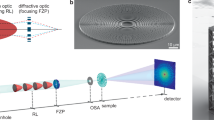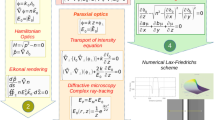Abstract
Fresnel lenses allow almost perfect imaging in widely different circumstances, but their focus is perfect only for a single wavelength. Wang et al.1 have shown how the effective bandpass may be widened for X-ray microscopy by using a compound diffractive/refractive lens near to an absorption edge. A compound lens has also been proposed for high-energy astronomy, working well above all absorption edges2,3. Although the scale is very different, we point out here that the principle is the same. Ever since Galileo constructed an astronomical telescope that he was able to reconfigure to study fleas and gnats, astronomy and microscopy have relied on optics that are closely related, but different in detail.
This is a preview of subscription content, access via your institution
Access options
Subscribe to this journal
Receive 51 print issues and online access
$199.00 per year
only $3.90 per issue
Buy this article
- Purchase on Springer Link
- Instant access to full article PDF
Prices may be subject to local taxes which are calculated during checkout

Similar content being viewed by others
References
Wang, Y., Yun, W. & Jacobsen, C. Nature 424, 50–53 (2003).
Skinner, G. K. Astron. Astrophys. 375, 691–700 (2001).
Skinner, G. K. Astron. Astrophys. 383, 352–359 (2002).
Gil, D., Menon, R. & Smith, H. I. J. Vac. Sci. Tech. B (in the press).
Jerius, D. et al. Proc. SPIE 4012, 17–27 (2000).
Gorenstein, P. Proc. SPIE 4851, 599–606 (2003).
NASA Structure and Evolution of the Universe Subcommittee. Beyond Einstein: From the Big Bang to Black Holes (NASA, 2003).
White, N. Nature 407, 146–147 (2000).
Cash, W. Proc. SPIE 4852, 196–209 (2003).
Author information
Authors and Affiliations
Corresponding author
Rights and permissions
About this article
Cite this article
Skinner, G., Gorenstein, P. Black holes, fleas and microlithography. Nature 426, 245–246 (2003). https://doi.org/10.1038/426245b
Issue Date:
DOI: https://doi.org/10.1038/426245b
Comments
By submitting a comment you agree to abide by our Terms and Community Guidelines. If you find something abusive or that does not comply with our terms or guidelines please flag it as inappropriate.



